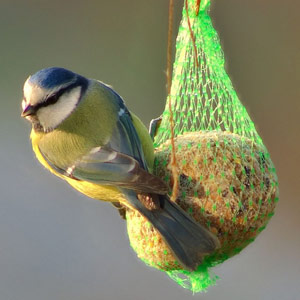Magazine | Analyses
Les facteurs influençant le nombre d’oiseaux visitant les mangeoires en hiver

Mésange bleue (Cyanistes caeruleus) sur une boule de graisse à Hamois en Belgique.Photographie : Luc Viatour / Lucnix.be
Introduction
Depuis le mois de décembre 2016, et malgré la récente vague de froid de janvier 2017, nous recevons des messages de visiteurs attristés du faible nombre voire de l’absence d’oiseaux fréquentant leurs mangeoires pourtant bien approvisionnées : ils se demandent si les oiseaux sont soudainement devenus plus rares, si l’emplacement choisi pour distribuer la nourriture et/ou la nourriture distribuée sont inadaptés, si leur chat est la cause de cette désaffection…
Dans cet article, nous énumérons les facteurs pouvant influencer le nombre et la diversité d’oiseaux visitant les jardins ou les balcons en hiver.
Abstract
Since the beginning of December 2016, we receive several messages from visitors that are worried by the lack of garden birds: many can’t understand why their feeders aren’t visited, despite being full of high-energy foods, which are usually in high demand at this periode of the year. They are worried they might have done something wrong, causing the birds to stay away. In this article, we present the factors that can influence the number and diversity of birds visiting gardens or balconies in winter,knowing that many of them can be combined.
Poursuivez la lecture de cet article, en vous abonnant dès maintenant !
Découvrez les Archives d’Ornithomedia.com
Pour seulement 10,00 €TTC/an (ou 6,00 € les 6 mois)
Profitez de plusieurs centaines d’articles en accès illimité et sans aucun engagement.
Compléments
À lire aussi sur Ornithomedia.com
- Comment les oiseaux passent-ils les nuits d’hiver et comment les aider ?
- Les effets possibles d’un printemps pluvieux sur la reproduction des oiseaux
- Nourrir les oiseaux : quelques précisions et conseils
- Nourrir les oiseaux en hiver : d’autres informations
- Quelles graines pour quels oiseaux ?
- Semez ou laissez pousser des fleurs qui produisent des graines pour les oiseaux
- Identifier les oiseaux du jardin en hiver
- Nourrir les oiseaux en été : oui, mais attention aux maladies
- Quand faut-il arrêter de nourrir les oiseaux : en mars ou en avril ?
- Prédation de l’Épervier d’Europe sur les oiseaux des jardins : que peut-on faire ?
- Aménager son jardin pour les oiseaux
- Comment les oiseaux supportent-ils les nuits d’hiver et comment les aider ?
Ouvrages recommandés
- Comment attirer les oiseaux sur son balcon ou dans son jardin de E Gismondi, Catherine Baldisserri (Traduction)
- Nourrir les oiseaux dans sa main de Wiberg
- Guide des oiseaux de nos jardins de Claude Feigné (Auteur) et Gérard Schmitt (Auteur)
- Le Traité Rustica des oiseaux du jardin de Guilhem Lesaffre (Auteur), Catherine Levesque (Auteur) et Emmanuel Risi (Auteur)
- Le guide des oiseaux autour de chez vous : Observer, Reconnaître, Nourrir, Protéger (Broché) de Gilles Leblais, Jean Chevallier (Illustrations), Allain Bougrain Dubourg (Préface)
- Nichoirs et Mangeoires de D. Colin
- Nichoirs et mangeoires pour les oiseaux de Ramu
- Attirer les oiseaux, les loger, les nourrir de A. Dion
- Alimentation des oiseaux de L. Peter
Sources
- Exeter (2013). Westcountry wildlife lovers: Where have all the garden birds gone? Express & Echo. Date : 13/12. www.exeterexpressandecho.co.uk/Westcountry-wildlife-lovers-garden-birds-gone/story-20316311-detail/story.html
- Richard A. Fuller, Philip H. Warren, Paul R. Armsworth, Olga Barbosa et Kevin J. Gaston (2008). Garden bird feeding predicts the structure of urban avian assemblages. Diversity and Distributions. Volume 14, numéro 1, pages 131–137. Onlinelibrary.wiley.com
- Dan E. Chamberlain, Andrew G. Gosler et David E. Glue(2007). Effects of the winter beechmast crop on bird occurrence in British gardens: Capsule Woodland birds were significantly less likely to occur in gardens in years of high beechmast crop. Bird Study. Volume 54, numéro 1. www.tandfonline.com/doi/abs/10.1080/00063650709461463#.Urbz66yXLXR
- C. J. Barnard (1980). Factors Affecting Flock Size Mean and Variance in a Winter Population of House Sparrows (Passer domesticus L.). Behaviour. Volume 74, numéro 1/2, pages : 114-127. www.jstor.org
- Gavin M. Siriwardena,Neil A. Calbrade, Juliet A. Vicker (2008). Farmland birds and late winter food: does seed supply fail to meet demand? Ibis. Volume 150, numéro 3, pages 585–595. onlinelibrary.wiley.com
- Benjamin Zuckerberg,David N. Bonter, Wesley M. Hochachka, Walter D. Koenig, Arthur T. DeGaetano, Janis L. Dickinson (2011). Climatic constraints on wintering bird distributions are modified by urbanization and weather. Journal of Animal Ecology. Volume 80, numéro 2, pages 403–413. Mars. onlinelibrary.wiley.com
- Jukka Jokimäki, Philippe Clergeau, Marja-Liisa Kaisanlahti-Jokimäki (2002). Winter bird communities in urban habitats: a comparative study between central and northern Europe. Journal of Biogeography. Volume 29, numéro 1, pages 69–79. Janvier. onlinelibrary.wiley.com
- Jukka Suhonen, Jukka Jokimäki, Marja-Liisa Kaisanlahti-Jokimäki, Harri Hakkarainen, Esa Huhta, Kimmo Inki, Petri Suorsa (2009). Urbanization and Stability of a Bird Community in Winter. Ecoscience 16(4). Pages : 502-507. www.bioone.org/doi/abs/10.2980/16-4-3280?journalCode=ecos




Aucun commentaire sur ce sujet
Participer à la discussion !